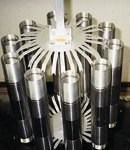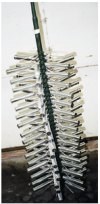Anodizing Influences
Rack materials can affect anodized coatings...
Many industrial and consumer products are anodized to provide corrosion resistance and/or a decorative finish to aluminum and aluminum alloys. The anodizing process normally involves a series of steps, including emulsion cleaning, inhibited alkaline cleaning, chemical etching, desmutting, anodizing and coloring. Each of these steps is followed by a rinse. The equipment used during anodizing includes processing tanks, DC power supplies, cathodes to improve coating quality, heat exchangers for bath temperature control and racking systems.
The quality of the anodized coatings is greatly influenced by the aluminum alloy used and by the process conditions. The racking system also affects the coating. An attempt has been made to improve the shortcomings of racking systems.
Rack material. The most commonly used rack materials are commercially pure titanium and aluminum alloys.
Commercially pure titanium racks are made of hot-rolled strips with 98.6 to 99.5 pct titanium, small amounts of iron and interstitial elements of oxygen, nitrogen, carbon and hydrogen. High interstitial content increases the strength and lowers the electrical conductivity. High oxygen can produce a hard brittle surface layer, and high hydrogen can lead to embrittlement or failure in service. ASTM Grade 3 annealed titanium has 65-ksi tensile strength, 55-ksi yield strength and holds its strength up to 400F. The modulus of elasticity is 16 x 106 psi. Pure titanium can be bent through an angle of 125 degrees around a diameter of normal thickness without cracking.1
Titanium is a noble metal with a zero to 0.5v electrode potential (in reference to a standard electrode). It is not attacked by sulfuric acid baths and is chosen as a racking material because of its good corrosion resistance and strength. Because aluminum is an active metal, the contact areas between titanium racks and aluminum could cause galvanic corrosion and local defects during anodizing. Titanium racks are best used for anodizing tubular-shaped products or those with holes.
Aluminum alloys commonly used for racks are 6063-T6 and 6061-T6 extruded alloy strips or wires. Alloy 6063 contains 0.7 pct magnesium and 0.4 pct silicon. T6 temper alloys require a 35-ksi tensile strength, 30-ksi yield strength and a 10 x 106-ksi elastic modulus. Alloy 6061-T6 has 1.0 pct magnesium, 0.6 pct silicon, 0.3 pct copper and 0.2 pct chromium. It has a 45-ksi tensile strength and 35-ksi yield strength.1 The machinability of aluminum alloys are high (300) compared to titanium (40). Aluminum alloys can easily be bent and provide easy loading and unloading of parts. Also, aluminum is a highly conductive metal compared to titanium.2
Aluminum alloys have a -0.83v electrode potential, are active metals and dissolve during anodizing. Aluminum racks anodize along with the workpieces and require stripping before reuse. However, they are considerably less expensive to manufacture, provide easy loading and unloading and have high current efficiency. They do have shorter service life compared to titanium racks, however.
Rack design. The racks used for anodizing generally consist of a spine and pins or discs attached to the workpieces. The spine is a strip with a hook at one end. It should be large enough to carry sufficient current to the work pieces. Pin racks normally contain at least two pieces per part with 0.5 to one inch of spacing to accommodate up to 100 parts per rack.
One of the requirements of rack design is that the rack should hold the workpieces rigidly and not allow them to fall off during anodizing. The deflection and stresses of pins and fingers to hold a workpiece can be estimated. Assuming two fingers with a cross section of 0.3 by 0.03 inch and 2.75 inches long, each deflected by D inches by a force, F, with an angle effect d of 8.14 inches, the firmness of holding the part (stiffness K) is given by the relation:
K = F/D = 3EI/dL3
where I is the moment of inertia (bt3/12 = 0.6975 in4) and F is one lb.
For aluminum fingers, E is 10 ×106 psi, K is 2.8 psi, D is 0.35 inches and the holding stress, s, is MC/I or 37,600 psi. In this case, the deflection of the fingers is high (0.35 inches). Because the holding stress of 37,600 psi is above the yield strength for 6061-T6, the fingers will be permanently deformed.
For titanium fingers, E is 16 × 106 psi, K is 4.45 psi and D is 0.22 inch. In this case, deflection of the fingers is low (0.22 inches). The holding stress is 37,800 psi, which is below the yield strength of titanium. This means there will not be any permanent deformation of the fingers.
Rack cover design. Aluminum pins and fingers with low stiffness have a tendency to loosen, causing the workpieces to fall off the racks during anodizing. Their recovery from the bottom of the tank is difficult. For chemical film finishing and anodized coatings using a paint base, surface blemishes are not critical. Flexible bags may be tied to the racks to catch the falling parts. The contact of the bag surface with the anodized coating can cause local defects. This is not acceptable for precision anodizing of aluminum parts. For these applications, a rack cover has been developed.3
The rack cover is made up of a cylindrical body, a base with a stiffener ring and support strips with wire hooks to attach the cylindrical body to the spine. The cylindrical body is made of thermoplastic netting, which is resistant to acid baths, alkaline cleaners and temperatures as high as 225F. The diameter of the cylindrical plastic netting is 15 inches or more. It is about 0.015 inches thick with 0.375-inch hole size. It is difficult to weld the netting to the base and have sufficient weld strength. Therefore, plastic ties attach the netting to the base and the stiffener ring. The cylinder is hung to the support strips at the top with hooks.
Because anodized coatings are priced at a fraction of the cost of finished aluminum parts, their loss during anodizing can cause a decrease in production while looking for the lost part. The rack cover has no current interference, is light, does not float and has easy-to-handle attachments for shop use.
REFERENCES
- Commercially pure titanium sheet, strip and plate, SAE/AMS Specification 4900K, 1991.
- Aluminum alloy sheet and plate specification ASTM B209, 1990.
- Nathan A. Tiner, et al, Rack Cover, U.S. patent No. 5435457, July 1995.
Related Content
Trivalent Chrome Overview
As the finishing industry begins to move away from the use of hexavalent chromium to trivalent chromium, what factors should finishers consider as they make new investments? Mark Schario, chief technology officer for Columbia Chemical offers a helpful overview of this complicated topic.
Read MoreProducts Finishing Reveals 2024 Qualifying Top Shops
PF reveals the qualifying shops in its annual Top Shops Benchmarking Survey — a program designed to offer shops insights into their overall performance in the industry.
Read MoreFinisher’s ‘Top Shop’ Status Attracts Business
This competitive California finisher made it a goal to become a PF Top Shop. After earning the recognition, the company experienced an immediate increase in business and a challenge to obtain certifications.
Read MoreRead Next
Delivering Increased Benefits to Greenhouse Films
Baystar's Borstar technology is helping customers deliver better, more reliable production methods to greenhouse agriculture.
Read MoreEpisode 45: An Interview with Chandler Mancuso, MacDermid Envio Solutions
Chandler Mancuso, technical director with MacDermid Envio discusses updating your wastewater treatment system and implementing materials recycling solutions to increase efficiencies, control costs and reduce environmental impact.
Read MoreA ‘Clean’ Agenda Offers Unique Presentations in Chicago
The 2024 Parts Cleaning Conference, co-located with the International Manufacturing Technology Show, includes presentations by several speakers who are new to the conference and topics that have not been covered in past editions of this event.
Read More
























